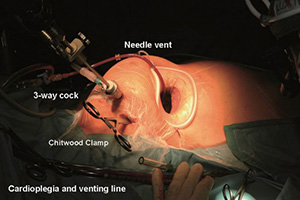Myocardial protection during minimally invasive mitral valve surgery: strategies and cardioplegic solutions
Abstract
Effective myocardial protection and perfusion strategies during minimally invasive mitral valve surgery (Mini-MV) have evolved over the last decade. Our institutional approach for right-sided Mini-MV has been standardized over the last 15 years in more than 4,500 cases. Cardiopulmonary bypass (CPB) is usually instituted by right-sided femoral arterial and venous cannulation with additional cannulation of the right jugular vein in patients with a body weight greater than 75 kg or when a concomitant tricuspid valve (TV) procedure and/or atrial septal defect closure is performed. A single dosage of crystalloid-based cardioplegia [Custodial- histidine-trypthophan-ketoglutarate (Custodial-HTK)] administered via the aortic root in combination with moderate hypothermia (34-35 °C) has become the standard of care for induction and maintenance of myocardial protection at our institution. The present article highlights and discusses the principal techniques of myocardial protection for Mini-MV.
Cover






